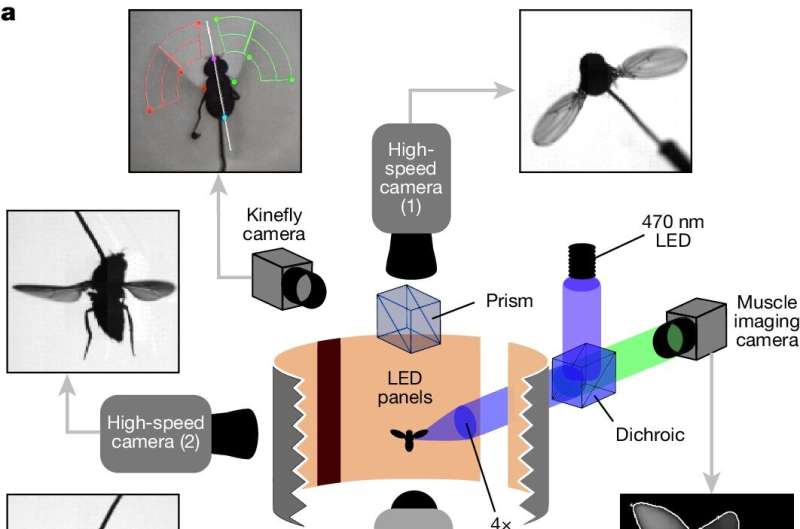This article has been reviewed according to Science X's editorial process and policies. Editors have highlighted the following attributes while ensuring the content's credibility:
fact-checked
peer-reviewed publication
trusted source
proofread
How insects control their wings: The mysterious mechanics of insect flight

Many of us would love the superpower to fly, and for good reason: Flight offers a crucial evolutionary advantage. Flying enables an animal to travel large distances quickly, in search of food and new habitats, while expending far less energy than walking. Through flight, insects colonized the planet and fostered the massive diversification of flowering plants by acting as efficient pollinators. They also enabled the evolution of other creatures like reptiles, birds, and mammals by serving as ample food supply.
Flight has evolved four times in the history of life on Earth: in birds, bats, pterosaurs, and insects. The first three groups of animals evolved their wings from arms, making these wings straightforward to understand as other similar animals have analogous bones and musculature. Insect wings, however, have no muscles or nerves. They are instead controlled by muscles located inside the body that operate a system of marionette-like pulleys within a complex hinge at the base of the wing.
"The fly wing hinge is perhaps the most mysterious and underappreciated structure in the history of life," says Michael Dickinson, Caltech's Esther M. and Abe M. Zarem Professor of Bioengineering and Aeronautics, and executive officer for biology and biological engineering. "If insects had not evolved this very improbable joint to flap their wings, the world would be a very different place, absent of flowering plants and familiar creatures like birds, bats—and probably humans."
Just how an insect controls this tiny, intricate structure in the fruit fly Drosophila melanogaster is the subject of a new study by Dickinson and his colleagues. Using high-speed cameras and machine learning, Dickinson's lab collected data on tens of thousands of fly wingbeats and created a map of how fly muscles puppeteer the motion of the wing hinge to create agile aerodynamic flight maneuvers.
The study was published in the journal Nature on April 17.
A fly's wing hinge contains 12 control muscles, with one neuron connected to each. For context, while a hummingbird possesses the same maneuverability as a fly, it uses thousands of motor neurons to execute similar flight maneuvers.
"We didn't want to just predict the wing motion; we wanted to know the role of the individual muscles," says Johan Melis (Ph.D. '23), the study's first author. "We wanted to tie together the biomechanics of the wing hinge to the neural circuits that control it."
First, the team created genetically engineered D. melanogaster in which the muscles controlling the wing hinge would glow with fluorescent light when activated. The researchers then placed the flies in a chamber with three high-speed cameras capable of capturing 15,000 frames per second to measure wing motion, and a microscope to detect the fluorescent activation of the fly's wing hinge muscles.
After collecting more than 80,000 wingbeats, the team applied machine-learning techniques to process the large volume of data and generate a map of how the 12 tiny control muscles act together to precisely regulate wing motion. Previous computer models of fly flight simply described the pattern of wing motion. The new model, in contrast, incorporates how the control muscles alter the mechanics of the wing hinge, producing wing motion.
In follow-up work, the team aims to create a detailed physics-based model that incorporates the biomechanics of the hinge with the aerodynamics of the wings and the underlying neural circuity within the fly's brain. The researchers also plan to collect data from other species of flying insects, like mosquitos and bees, to understand how wing structures evolved to allow sophisticated flight behaviors.
The ultimate goal is to understand the neurobiological connection between a fly's brain and the movement of its wings. "The wing hinge is just the hardware; the real passion in our lab has been the brain–body interface," Dickinson says.
"We want to understand the circuitry between the biomechanics and the neurobiology. Very few times in evolution has an animal had one very successful form of locomotion—walking—and simply added another one—flying. This means that the brains of insects must have all the circuitry to regulate to completely different means of moving."
More information: Johan M. Melis et al, Machine learning reveals the control mechanics of an insect wing hinge, Nature (2024). DOI: 10.1038/s41586-024-07293-4
Journal information: Nature
Provided by California Institute of Technology



















